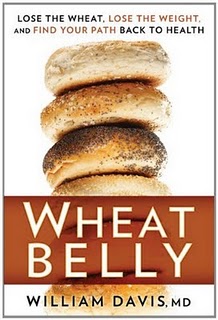So who cares if the wheat we’re eating today was hybridized in a lab and is found in almost everything we consume? Well, analyses of this hybridized wheat found that 5% of the protein to be unique, not found in either parent. What this means is that this new version of wheat has protein in it that is not found in nature. How do we expect our bodies to properly breakdown and utilize a protein it was not designed to be ingesting?
 This is again why those with Celiac or other wheat sensitivities have such strong reactions including nausea, cramps, foggy brain, insomnia, irritability, etc. But even without being diagnosed, I propose that many subtle symptoms such as eczema, fatigue, mood swings, sugar cravings and acne are due to wheat intake. I just read an article in Better Nutrition (October 2012) about a woman who’s eczema completely cleared up in seven days after excluding wheat from her diet. In addition, modern wheat has a crazy impact on blood sugar levels. Eating two pieces of whole wheat bread drives up sugar levels higher than eating a candy bar or drinking a can of soda! (Note: This concept was first launched in 1981 when the University of Toronto showed the glycemic index (GI) of whole grain bread was 72, while that of sucrose (table sugar) was 59). The higher your blood sugar levels, the more insulin released and the more likely you are to store that glucose as fat. This is also responsible for the highs and lows of satiety and hunger that wheat eaters experience throughout the day.
This is again why those with Celiac or other wheat sensitivities have such strong reactions including nausea, cramps, foggy brain, insomnia, irritability, etc. But even without being diagnosed, I propose that many subtle symptoms such as eczema, fatigue, mood swings, sugar cravings and acne are due to wheat intake. I just read an article in Better Nutrition (October 2012) about a woman who’s eczema completely cleared up in seven days after excluding wheat from her diet. In addition, modern wheat has a crazy impact on blood sugar levels. Eating two pieces of whole wheat bread drives up sugar levels higher than eating a candy bar or drinking a can of soda! (Note: This concept was first launched in 1981 when the University of Toronto showed the glycemic index (GI) of whole grain bread was 72, while that of sucrose (table sugar) was 59). The higher your blood sugar levels, the more insulin released and the more likely you are to store that glucose as fat. This is also responsible for the highs and lows of satiety and hunger that wheat eaters experience throughout the day.
When your body experiences these surges in blood sugar consistently, more fat accumulates as a result. Dr. William Davis likes to describe it as “Wheat Belly,” which is also the name of his book on the topic. He says, “The bigger your wheat belly, the poorer your response to insulin, since the deep visceral fat of the wheat belly is associated with poor responsiveness, or ‘resistance,’ to insulin, demanding higher and higher insulin levels, a situation that cultivates diabetes.” Also, more estrogen is produced by fat tissue, leading to man boobs. What’s worse, more inflammatory responses are triggered, leading to heart disease and cancer.
One of the most profound discoveries about wheat is that it stimulates the appetite. Wheat eaters consume an average of 440-800 more calories per day than non-wheat eaters! Why is this? A component in gluten called gliadin is broken down into polypeptides when eaten. Polypeptides are small enough to cross the blood-brain barrier and bind with opiate receptors, then causing addiction and increased appetite. Think about it-after you eat bread, rolls or bagels, do you crave chicken? Usually not-you crave more carbs. And since wheat is hidden in everything from TV dinners to candy, your sweet tooth might really be a wheat tooth. Part 3 will discuss what you can do to avoid or reduce your gluten intake.
*The information on this site is designed for educational purposes only and has not been evaluated by the Food and Drug Administration. It is not intended to be a substitute for informed medical advice or care. You should not use this information to diagnose, treat, cure or prevent any health problems or illnesses without consulting your pediatrician or family doctor. Thank you!
~by Kimberly Olson
About Me





